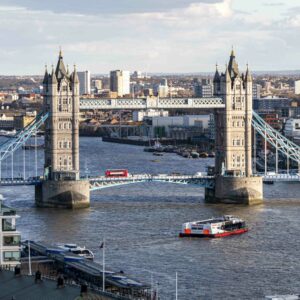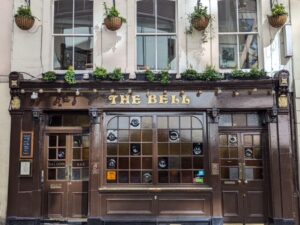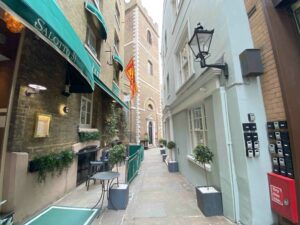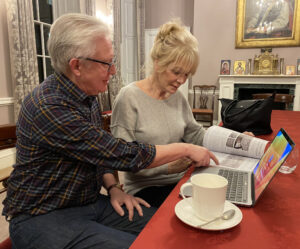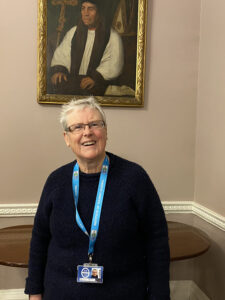In Part 1 of this blog, we explored the Wren City Churches that are still functioning as churches, and in this Part 2 we explore the lost Wren Churches that have disappeared entirely or have been transformed into office spaces, gardens or private residences.
This loss and transformation came about as, following the Great Fire, the City Churches faced two more waves of destruction in their history; firstly in the form of the Union of the Benefices Act in 1860 and secondly in the form of World War II and the Blitz, which hit London particularly hard.
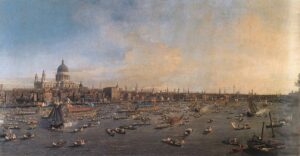
The Union of the Benefices Act freed up land for commercial development in the City, after a decline in the population in the Victorian period led to parishes being combined, and this resulted in some Wren churches being demolished.
The Blitz was a German bombing campaign that lasted from September 1940 to May 1941, and 29th
December 1940 was the worst night of bombing, when 136 bombers dropped 10,000 incendiary and high explosive bombs on the City of London. 18 City churches were destroyed in the Blitz, including 15 Wren Churches, and while some of the destroyed churches were rebuilt, some were not. In this Part 2 we explore these lost or transformed churches.
Church Towers and Romantic Ruins
We start with the lost churches which are not completely gone and are now either a solitary church tower which has found a second life as commercial property or private residences, or whose ruins have been preserved and converted into the most atmospheric gardens you can find in the City, beloved by Instagrammers and city workers alike.
25. Christ Church Greyfriars
This is another church with a magnificent Wren steeple, and it sits close to St Pauls. The original church was in the Gothic style but was rebuilt post fire in the English Baroque style by Wren, and was described by Wren Junior as ‘spacious and beautiful’. It is said that the church boasted just about every decorative feature at Wren’s disposal, including ornamental pineapples plus lanterns enclosed by twelve vases. Overall, the tower is 153 feet high making it second only to St Brides.
On 29th December 1940, Christchurch Greyfriars was hit by a fire-bomb and the flames tore through the interior. The entire church, except for the tower, was destroyed and the only fitting that was recovered was the wooden cover of the font which can now be found in the porch of St Sepulchre-without-Newgate.
In 1949 it was decided not to rebuild the church and instead turn it into a gorgeous garden, and amidst this garden it stands a dignified ruin with roses and lilies replacing the pews. The tower still stands and was converted to a twelve-storey residence, and in 2012 was on the market for just under £4 million.
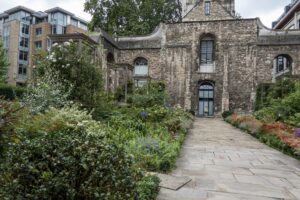
26. St Alban, Wood Street
An unusual perpendicular Gothic style – the church was gutted during WW2 and only the Tower remains standing on a traffic island between modern office buildings on one side and the Wood Street police station on the other. It was converted into a private residence in 1985.
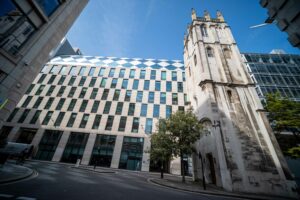
27. St Augustine Watling Street
Wren rebuilt the church and the tower with the intention that the steeple should act as a counterpoint to the great dome of St Paul’s Cathedral. The church unfortunately was destroyed by Second World War bombing, but its tower survived and was incorporated into the Cathedral Choir School in 1962-67.
28. St Dunstan-in-the-East
This church is now a roofless ruin and one of the prettiest pocket gardens in the City, having been ruined by bombing in WW2. The delicate and elegant tower and steeple are the only parts of the church that can be credited to Wren, with the spire rising majestically from a crown of four flying buttresses.
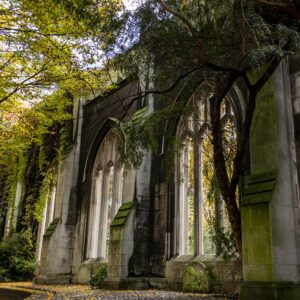
29. St Mary Aldermanbury
Now a garden located close to the City of London Corporations offices, the church was rebuilt by Wren in Portland stone after the Great Fire of London in 1966 but again destroyed during the Blitz in 1940. The walls remained and these were re-erected in the grounds of Westminster College, Fulton, Missouri as a memorial to Winston Churchill who had given his famous Iron Curtain Speech at the college. A plaque in the garden in London commemorates this.
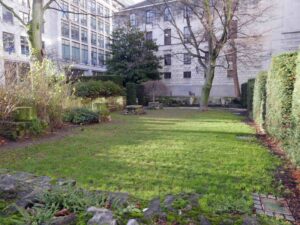
30. St Mary Somerset
When the parish of St Mary Somerset was united with the neighbouring parish of St Nicholas
Cole Abbey, the church was demolished but the tower was spared as it is considered one of Wren’s (or possibly Hawksmoor’s) finest, with the pinnacles and obelisks on the tower seeming to change heights from different angles. The tower was used as a rest room for women working in the City during WWII. The interior is currently being refitted.
31. St Olave Old Jewry
A church once located between Ironmonger Lane and Old Jewry (click here to see its location on the Agas map). The church was rebuilt by Wren in 1673-76 and was demolished in 1888 when the parish was united with St Margaret Lothbury, with the exception of the church tower which today is private offices with a delightful small garden. Excavation in the mid 1980’s found Saxon foundations and roman tiles.
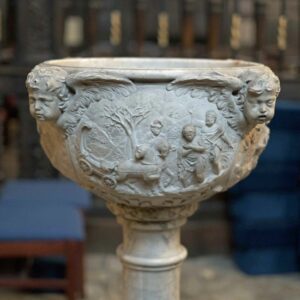
Gone, but not forgotten
Twenty of Wren’s churches have been completely lost. The ghosts of these lost Wren churches can still be felt in the blue plaques that mark their location, the parish boundary markers that define the limits of their parish and in the artefacts and memorials which were saved and swallowed by the Wren churches still existing today.
32. All Hallows Bread Street
John Milton was baptised here in 1608 and when the church was destroyed in the Great Fire, Wren rebuilt it with a fine arcaded tower with pinnacles. Construction began in 1681 but had to stop in 1684 as Wren was having difficulty paying for the construction of several City churches and St Paul’s Cathedral from the Coal Tax receipts. The church was completed in 1697 after lobbying from the Lord Mayor.
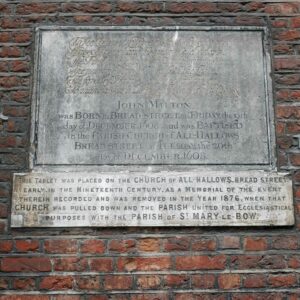
A tablet showing a carving of John Milton used to stand on the corner of Bread St and Watling St, but was destroyed in World War II and now a plaque recording Milton’s baptism is on the wall of St Mary le Bow, the church with which All Hallows Bread St was united in 1876 due to the falling number of parishioners. The church was demolished two years later.
33. All Hallows Lombard Street
All Hallows had been here since Saxon times, having been mentioned in 1054 as a gift to Canterbury Christchurch. It was rebuilt by Wren in 1689-1694 on the north side of Lombard Street quite close to the junction with Gracechurch Street – eventually though, hemmed in by office buildings. It fell into disrepair and was pulled down in 1939, though the Tower, porch and furnishings were used in the church of All Hallows on the Chertsey Road, Twickenham.
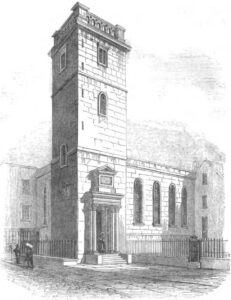
34. All Hallows the Great
Situated in what is now Upper Thames Street, and rebuilt by Wren after the Great Fire, it was united with St Michael Paternoster Royal and finally demolished in 1894 to widen the street. The rebuilt brick tower and part of the churchyard survived until 1964, when they were destroyed to make way for the City Fire Station. Its chancel screen is in St Margaret Lothbury, and its brass chandelier and statues of Moses and Aaron are in St Michael Paternoster Royal.
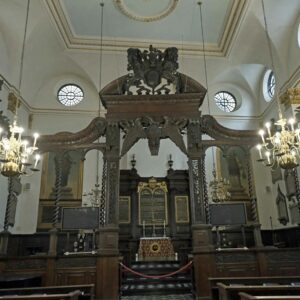
35. St Antholin, Budge Row
Rebuilt in 1678-84 by Wren, the church had an octagonal ribbed tower and the ceiling was in the form of an oval dome, supported on eight columns standing on high plinths. George Godwin, writing in the 19th century, noted that “the carpentry of the roof displays Wren’s knowledge of constructive science, and may be studied with advantage.”
John Wesley preached here several times, noting in his journal that so many people were wedged in that he had difficulty getting into the church. Demolished in 1874 to make way for the building of Queen Victoria Street, part of the church’s distinctive tower can be found at Round Hill, Forest Hill in south London. A plaque depicting the church can also be seen on the wall of St Mary Aldermary.
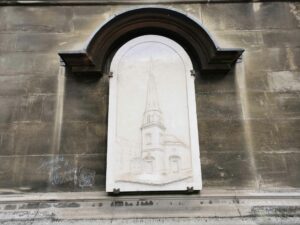
36. St Bartholomew-by-the-Exchange
Stood on the south-east corner of Bartholomew Lane and Threadneedle Street. The tower had an unfinished appearance, and it was believed that Wren either kept the original tower or had produced a replica of it. Demolished for the rebuilding of the Royal Exchange after the fire in 1838 so that Threadneedle Street could be widened. Pictures of the church can be found on the London Picture Archive.
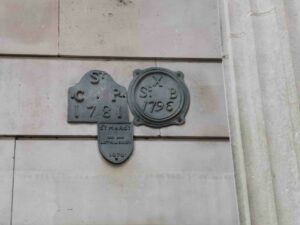
37. St Benet Fink
St Benet (St Benedict) Fink (the surname of a 13th century benefactor) stood on what is now Threadneedle Street. The walls of the church formed a decagon, and it had a square tower surmounted by a dome and a small cupola. It was demolished in stages from 1841-46 following a fire at the Royal Exchange in the winter of 1838.
38. St Benet Gracechurch
Located on the corner of Gracechurch Street with Fenchurch Street, today the site is occupied by a Boots store. It was called “grass church” due to the herb market held opposite its west door. It was demolished in 1868 so that Gracechurch Street could be widened. The pulpit of the church is now in St Olave Hart Street.
39. St Christopher le Stocks
The first of Wren’s 51 churches to be pulled down. After the Gordon Riots in 1780, the Bank of England was concerned by the possibility of similar groups occupying this church, and having already gained almost all its parish, the church was demolished and the Bank of England was enlarged. Its parish boundary marks are on the wall of the Bank of England in Princes Street and Threadneedle Street.
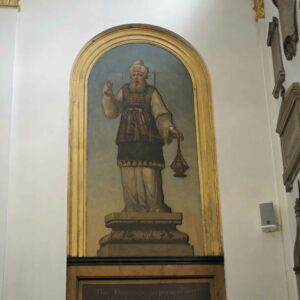
40. St Dionis Backchurch
Located on the corner of Fenchurch St and Lime St, this was the only church in the City dedicated to the patron saint of France, St Dionis. It was named “backchurch” as the church lay back from the street behind a row of houses and shops. It was rebuilt after the Great Fire and demolished in 1878 when the parish was united with All Hallows Lombard Street, and its communion table, pulpit and font are still in use at St Dionis, Parsons Green, the building of which was funded by the proceeds of the sale of the site where the church was located.
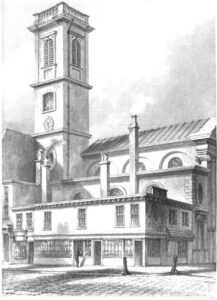
41. St George Botolph Lane
St George Botolph Lane was a church off Eastcheap, in the ward of Billingsgate in the City of London. It was the only church in the City dedicated to St George and the rear of the church overlooked Pudding Lane, where the fire of London started in 1666. It was first recorded in the twelfth century, was destroyed in the Great Fire of 1666, and rebuilt by Wren allegedly out of the rubble of Old St Paul’s. It was demolished in 1904 when the parish was united with St Mary at Hill.
Unusually it was built on a stepped platform called a stylobate, as the site was originally low-lying and sloped downhill towards the Thames, so Wren raised the level and made it even by the construction of a platform.
The most famous character associated with the church was Lord Mayor and MP for the City of London, William Beckford. The sword rest used during his 1770 mayoral visit has the inscription “Sacred to the memory of that real patriot the Right Hon. William Beckford, twice Lord Mayor of London: whose incessant spirited efforts to serve his country hastened his dissolution.” It is now in St Mary-at-Hill.
The last service at the church was held in 1890, and in May 1900 a letter to The Times reported that not only had the church been condemned as structurally unsafe, but that the accumulation of human remains in the vault had become a health hazard.
42. St Mary Magdalen Old Fish Street
This is one of the most lost churches of them all, as the church’s exact location is unknown. It was located on the eastern part of Knightrider St (previously Old Fish Street due to the proximity of the fish market), but its location is now lost due to the redevelopment of Knightrider St and Old Change after WWII. It was pulled down following a fire in a nearby warehouse on Knightrider St on 2nd December 1886 which spread to the roof of the church. The church was then united with St Martin Ludgate which still has some of the fixtures from the church, including the wooden bread shelves for the poor.
43. St Matthew Friday Street
St Matthew Friday Street was located between Cheapside and Watling Street and called “Friday Street” due to the fishmongers who lived nearby and served at the Friday markets.
Its most famous parishioner and churchwarden was Hugh Myddleton, the creator of the New River Company which brought fresh water to the City in 1613. He was buried here before the Great Fire and when the church was rebuilt, they tried unsuccessfully to find his coffin.
One of Wren’s cheapest churches, it was very plain, and was united with St Vedast alias Foster and pulled down in 1885. It did, however, have a finely carved font and cover that is now in St Andrew by the Wardrobe.
44. St Michael Bassishaw
St Michael Bassishaw was a parish church in Basinghall Street in the City of London, and its site is now covered by the courtyard of the Guildhall offices and the Barbican highwalk.
Its unusual name comes from ‘Basing’s haw’, ‘Basing’ being the name of a prominent family in medieval London and ‘haw’ meaning yard. The north wall of the 12th century church had been built over Roman and medieval rubbish pits, so had to be strengthened by buttresses.
Poor foundations caused problems over the centuries, exacerbated by the fact the walls were faced with brick, instead of the usual stone, and the load-bearing Corinthian columns were described as “specimens of…jerry-building…made up of several sorts of materials and plastered over”. By 1892 the church was judged unsafe and was closed, its parish combined with that of St Lawrence Jewry. St Michael Bassishaw was demolished in 1900 and the land sold to the City of London Corporation for £36,000.
The plaster coat of arms in St. Michael Bassishaw – the grandest of those in any Wren church – can now be found in the Guildhall complex. The ball and finial from its steeple, designed by Robert Hooke, are now on the spire of St Andrew by the Wardrobe.
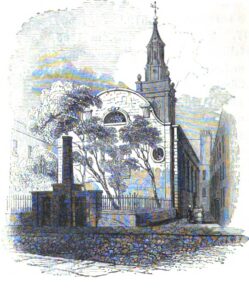
45. St Michael, Crooked Lane
Demolished to make room for the new approaches to London Bridge in 1831, the church was located on Crooked Lane, once famous for its bird cages and fishing tackle shops. The interior was described as “so plain as to be indescribable”, but the tower was “remarkably picturesque” with vases, a clock, weathervane and cross.
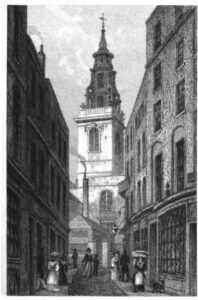
46. St Michael Queenhithe
St Michael’s, located immediately opposite Queenhithe dock, was demolished in 1876 when the church was untied with St James Garlickhythe. Its weathervane, a model of one of the corn ships that would have docked at Queenhithe, can still be seen on top of the tower of St Nicholas Cole Abbey.
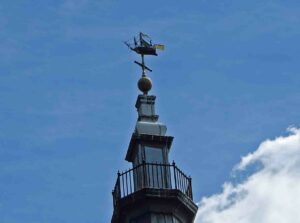
47. St Michael Wood Street
This church stood on the west side of Wood Street and the corner of Huggin Lane. The medieval walls survived the Great Fire and the parishioners were so keen for the church to be rebuilt that they paid 15 pounds 5 shillings for a dinner for Dr Wren. Despite the wining and dining, this was one of Wren’s least expensive churches and any architectural merit the church may have had was destroyed by the Gothick enhancements made by the Victorians. The church was demolished under the auspices of the Union of Benefices Act in 1897 and Huggin Lane was swallowed up in post-war rebuilding.
Pictures of the church can be found on the London Picture Archive
48. St Mildred, Bread Street
St Mildred was one of Wren’s finest and least altered City Churches. The construction was led by Edward Strong the Elder, the father of the father and son duo who worked on St Paul’s Cathedral and had a plastered dome decorated with cherubs. One of the few churches that had its original Wren fittings in the 20th century, it was destroyed by bombing in 1941. However, some original registers survived the bombing and record that it was where Percy Bysshe Shelley married Mary Wollstonecraft Godwin in 1816.
49. St Mildred, Poultry
The church was situated in the busy Poultry market and so suffered from the traffic noise of carts and coaches. The parish was united with that of St Olave Jewry and the church was sold and demolished under the Union of Benefices Act in 1872, and the proceeds of sale were used to build the church of St Paul, Goswell Road. The church was dedicated to St Mildred, a Saxon abbess in Thanet, who encouraged trade and navigation to benefit people and who even owned a vessel which regularly traded with the port of London. This trade was commemorated on the pulpit which had a carving of a ship in full sail, which is now at St Paul’s, Goswell Road, and on the weathervane which now resides on top of St Olave Jewry.
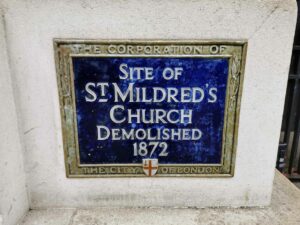
50. St Stephen Coleman Street
Located on the corner of Gresham Street and Coleman Street, St Stephen’s parish boundary marker can be seen on Coleman St, complete with a cockerel in a hoop. This commemorates a bequest from John Sokelynge of his brewery on Coleman Street called “La Cokke on the Hoop”. A stone version of this cockerel was salvaged when the church was to be finally demolished after being destroyed during the Blitz and is now in the safekeeping of the Museum of London (currently closed while its new home at West Smithfield is being completed).
51. St Swithin, London Stone
Wren’s church was rectangular, covered by an oval dome and with a tower at the northwest corner. Three sides of the church each had three windows, and the side on Cannon Street was decorated with a carved relief and stone drapery.
Its name comes from the London Stone, a piece of limestone of Roman origin, that used to be located opposite the church on Candlewick St (now Cannon St). Many myths have been attributed to the London Stone, including that if it is removed, London will fall. The London Stone was first set near the church door in 1742 and then later in an alcove in the wall of the church.
The church was badly damaged in World War II and subsequently demolished, but its location is still marked by the London Stone that is still set in an alcove of the building that replaced it at 111 Cannon Street.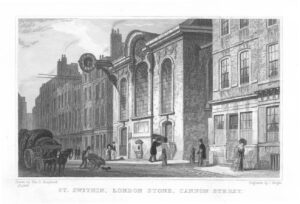
St Swithins London StoneIf you’re interested in seeing Wren’s churches, come on one of our walks celebrating Wren300 which run monthly from April to August.
Authors: Caroline Powell, Courtney Plank, Freda Dahl-Nielsen, Jane Copland and Ildiko Bita

